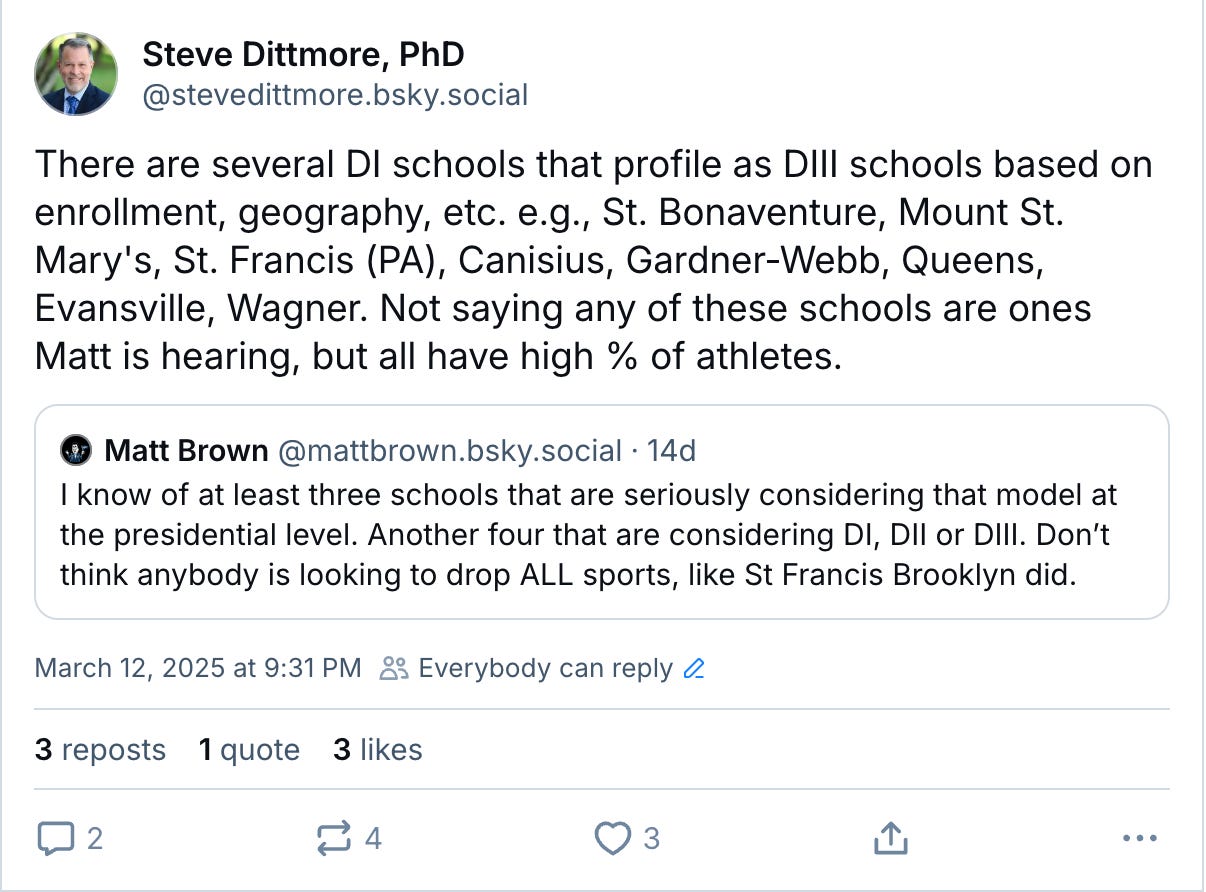Saint Francis University becomes first D1 to decide not to challenge athletic headwinds
What other D1 schools might be considering the same thing?
Today’s announcement of Saint Francis University’s (PA) reclassification from D1 to D3 was certainly big news, at least in the circle of people I follow on social media. I had been wanting to respond to Matt Brown’s March 11 post about hearing that several D1 schools were seriously considering transitioning out of D1. In fact, I had opined about the economic reality of D1 athletics, and the ability to stay in D1, during a February 5 post about Cleveland State.
In responding to Matt’s post on BlueSky, I mentioned Saint Francis as a school that profiles as D3 based on enrollment and geography, so this move makes sense.
What did I mean when I said the school profiles as D3? First, geography. Loretto, Pennsylvania is in the western-middleish part of the state, roughly equidistant from I-80 to the north and the PA Turnpike to the south. The closest “big” city is Altoona, less than 30 minutes away.
Joining the Presidents’ Athletic Conference will ease travel costs considerably when compared to the Northeast Conference, whose full members stretch from Stonehill College between Boston and Providence west to Chicago State.
Second, enrollment. According to EADA data from 2022-23 (the most recent reporting year on the site), Saint Francis’ enrollment was the seventh lowest in all of Division 1, with 1,490 reported undergraduate students. New conference foe Allegheny College, for example, checks in with 1,315 undergraduates. Small, rural, private liberal arts colleges dominate D3.
Third, percent of athletes as undergraduates. Anyone who has spent time reading Glory Days knows the perils of getting to 44 percent or higher athletes on campus. In the last EADA reporting year, only two D1 schools eclipsed the 44 percent threshold - Presbyterian College (51.1%) and Queens University (44.1%). Saint Francis, however, was trending that way. Its percentage of athletes (35.2%) was the fifth highest in D1. Consider the chart below of the 15 smallest D1 institutions by reported undergraduate enrollment.

Some of those schools (Chicago State, Queens, Coppin State, Wagner, Canisius, Saint Peter’s) are in bigger cities, while others (Gardner-Webb, Mount St. Mary’s, St. Bonaventure) are rural like Saint Francis and profile as D3. That’s not to say D3 schools don’t exist in big cities, many do (e.g., NYU, MIT, Carnegie-Mellon).
Ultimately, the decision of D1 v. D3 will be a campus-by-campus case study with multiple factors contributing to the conversation including the House settlement, demographics, and other economic variables. To me, a key question should be “who do we compete against for students?” Enrollment managers will know what other schools a student is considering. If a student was considering Saint Francis because they wanted to watch, or play, D1 sports on weekends, then the university may not retain that student. And they have to be okay with that. But if, as I suspect, a student was torn between Saint Francis, a Franciscan university, and new PAC opponent Franciscan University of Steubenville, then aligning with like-minded schools might prove beneficial.
To Saint Francis’s credit, the communications execution of the announcement was well done. The transition website anticipates many of the questions students, alumni, and stakeholders will have. As the first school in the NIL era to reclass, Saint Francis is navigating untraveled waters about messaging. In its FAQ, the response to a staged question of why make the move to D3 was, “Rather than fighting against the headwinds and logistics that make being a small school in the NCAA Division I unsustainable, our Board of Trustees made the bold move to place our students’ academic success and well-being first.”
I wonder which of the remaining 14 schools on the above list were watching today’s news with an eye toward their own announcement.







Why are you specifically mentioning schools by name? Huge disrespect.